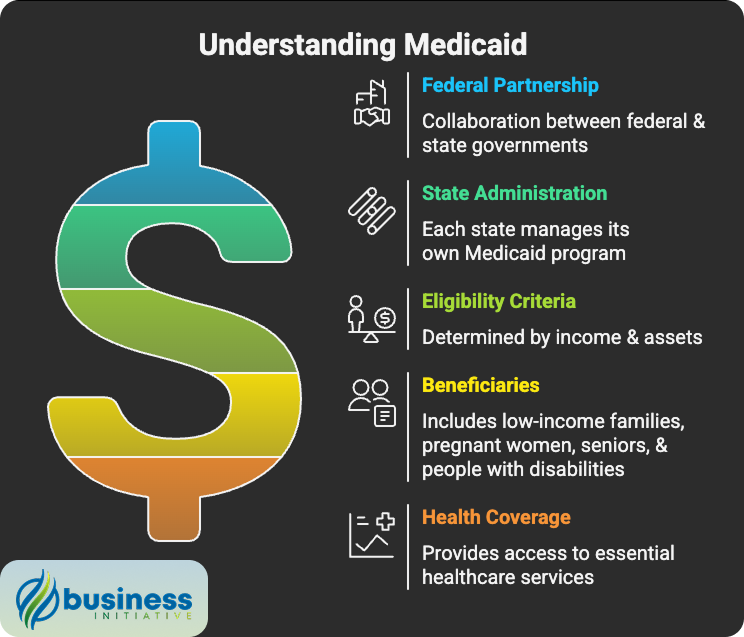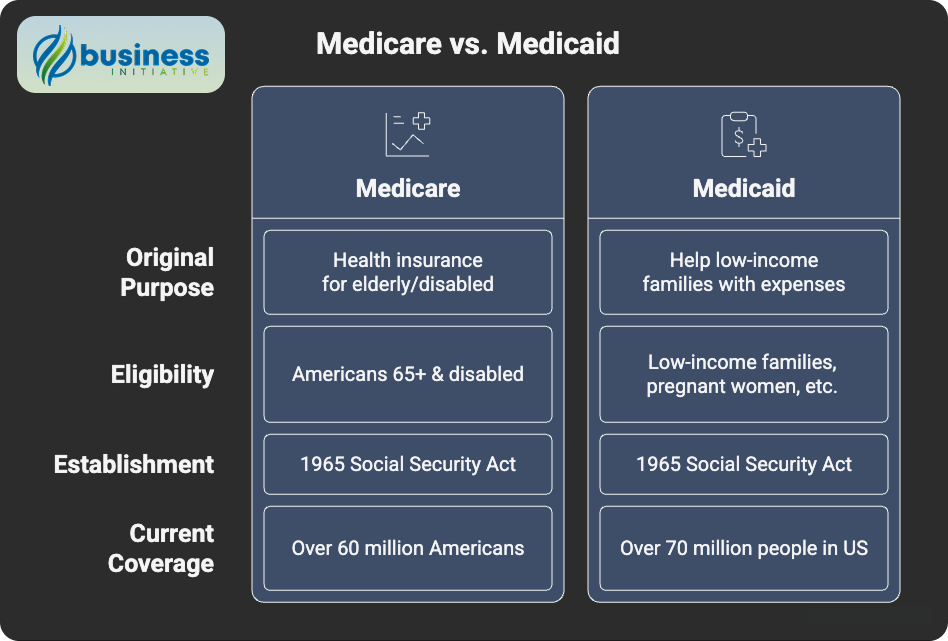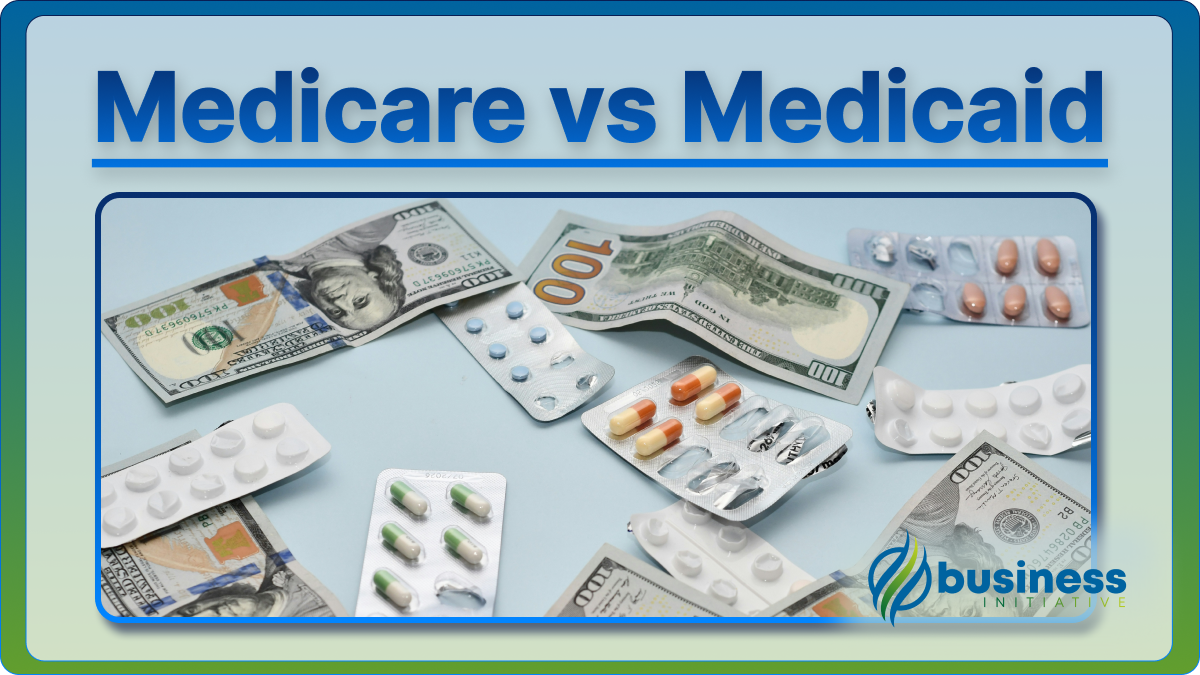In the United States, healthcare is a complex and sometimes confusing system.
Two of the most well-known government-funded healthcare programs are Medicare and Medicaid.
At first glance, these programs may seem similar, but there are significant differences between them.
Below, we compare Medicaid vs Medicare so you can quickly understand eligibility, coverage, and typical costs.
 Key Takeaways
Key Takeaways
- Medicare is a federal program, while Medicaid is both state and federally funded.
- Medicare primarily serves seniors aged 65 and older, whereas Medicaid assists low-income individuals and families.
- Eligibility for Medicare largely depends on age, while Medicaid focuses on income level.
- Medicare has four distinct parts (A, B, C, and D) that cover various services; Medicaid benefits vary by state.
- Entrepreneurs should consider their target demographics when evaluating the potential impact of these programs on their businesses.
In this article, we will explore these differences in depth, provide relevant statistics and examples, and point you towards additional resources for further exploration.
 Table of Contents
Table of Contents
- The Big Picture: Fundraising Landscape in 2024
- Harnessing the Power of Monthly Giving
- Understanding Donor Behavior
- Sector-Specific Opportunities
- Boosting Digital Impact: Donation Pages and Websites
- Beyond Digital: Direct Mail and DAFs
- For Business Owners: Partnering with Nonprofits
- FAQs about Small Business SEO
- Conclusion
What is Medicare?

Medicare is a federal health insurance program that primarily provides coverage for people aged 65 and older, as well as certain younger individuals with disabilities and end-stage renal disease (ESRD).
For many, Medicare functions as health insurance for over 60, with full eligibility at 65 and specific disability pathways for younger adults.
Established in 1965 under the Social Security Act, Medicare is divided into four parts:
1. Part A (Hospital Insurance): Covers inpatient hospital stays, skilled nursing facility care, hospice care, and some home health services.
2. Part B (Medical Insurance): Covers doctor services, outpatient care, medical supplies, and preventive health services.
3. Part C (Medicare Advantage): A private insurance alternative to Parts A and B, offering additional benefits and usually including Part D.
4. Part D (Prescription Drug Coverage): Offered through private insurance companies, this covers outpatient prescription drugs.
To illustrate this concept further, let’s say an elderly individual who requires hospitalization for a medical condition would have the cost of their inpatient care covered by Medicare Part A.
What is Medicaid?

Medicaid is a state and federal partnership program that provides health coverage for low-income Americans, including families with children, pregnant women, seniors, and people with disabilities [1].
Established in 1965 alongside Medicare, Medicaid is means-tested and eligibility is determined by income and assets.
Each state administers its own Medicaid program with federal guidelines, which means that eligibility and benefits may vary from state to state.
As an example we could say a low-income family with children would receive comprehensive health coverage through their state’s Medicaid program, ensuring access to essential healthcare services.
The History of Medicare & Medicaid

Medicare and Medicaid were both established in 1965 under the Social Security Act, signed into law by President Lyndon B. Johnson.
At the time, about half of all Americans over 65 did not have health insurance, and many low-income families also lacked access to affordable healthcare.
The original purpose of Medicare was to provide health insurance for older Americans and individuals with disabilities who were unable to work.
Medicaid, on the other hand, was designed to help low-income families and individuals with medical expenses.
Over time, both programs have evolved to meet changing healthcare needs and demographics.
In 1972, Congress expanded Medicare eligibility to include individuals with long-term disabilities and end-stage renal disease (ESRD).
In the following decades, additional changes were made to expand coverage for preventive care services and prescription drugs.
Similarly, Medicaid has undergone numerous changes since its inception.
In 1986, Congress required states to cover pregnant women and children up to age six; this was later expanded in 1990 to include children up to age 18.
The Affordable Care Act (ACA) of 2010 further expanded Medicaid eligibility to include all adults with incomes up to 138% of the federal poverty level (FPL), although some states have opted out of this expansion.
Today, Medicare provides health insurance for over 60 million Americans aged 65 and older as well as individuals with disabilities.
Medicaid covers more than 70 million people in the United States, including low-income families with children, pregnant women, seniors, and people with disabilities.
Key Differences Between Medicare & Medicaid

While both programs provide health coverage, there are several key differences between Medicare and Medicaid:
1. Eligibility
Medicare is primarily for individuals aged 65 and older or with certain disabilities, while Medicaid is for low-income Americans.
2. Costs
Medicare beneficiaries may be responsible for premiums, deductibles, and co-payments, while Medicaid often has little to no out-of-pocket costs for eligible individuals.
3. Coverage
Medicare is divided into four parts (A, B, C, and D), while Medicaid covers a wider range of services, including long-term care and nursing home services.
In 2020, Medicare provided coverage for approximately 62.6 million Americans, while Medicaid provided coverage for approximately 73.6 million Americans [2].
4. Spending
Medicare spending was about $925.8 billion in 2020, while Medicaid spending was about $613.5 billion in 2019 [3] [4].
5. Administration
Medicare is a federal program, while Medicaid is jointly funded and administered by state and federal governments.
6. Beneficiary Access
Studies show Medicaid beneficiaries have lower access to healthcare services than Medicare beneficiaries.
7. Quality of Care
Medicaid beneficiaries may receive lower quality of care than Medicare beneficiaries.
8. Health Outcomes
It is important to note that these findings do not necessarily mean that one program is better than the other overall.
Rather, they highlight the need for continued efforts to improve access to care and health outcomes for all Americans regardless of their insurance coverage.
In Summary…
Knowing the differences between Medicare and Medicaid is crucial for anyone who wants to make informed decisions about their healthcare coverage.
Whether you are an entrepreneur looking to target a specific demographic or an individual trying to navigate the complex healthcare system, knowing the eligibility requirements, coverage options, and costs associated with these programs can help you make the best choices for your unique situation.
By utilizing the information provided in this article, you can gain a better understanding of how Medicare and Medicaid work and determine which program may be right for you or your loved ones.
You can also use this knowledge to evaluate the potential impact of these programs on your business and adjust your strategy accordingly.
If you have further questions or would like personalized assistance navigating the healthcare system, we encourage you to fill out our contact form for a quicker response from us.
We are dedicated to helping individuals and businesses make informed decisions about their healthcare coverage and would be happy to assist you in any way we can.
Don’t forget to sign up for our newsletter and follow us on X (Twitter) for more valuable insights into healthcare policy and practice.
Together, we can create a healthier future for all Americans.
FAQs - Frequently Asked Questions About Medicare & Medicaid

What is the difference between Medicare and Medicaid?
Medicare is a federal program mainly for people 65+ and some with disabilities.
Medicaid is a joint federal-state program for low-income individuals and families.
Learn More...
Medicare is administered by the federal government and focuses on seniors 65+ and certain people with disabilities or ESRD.
Medicaid is jointly funded and administered by states and the federal government, with eligibility based primarily on income and assets.
Medicare has four parts (A, B, C, D) that define coverage, while Medicaid benefits vary by state and can include services like long-term care.
- Medicare = federal administration.
- Medicaid = state + federal administration.
- Medicare parts A, B, C, D define coverage.
- Medicaid benefits differ by state and often include long-term care.
For official details, compare programs on Medicare.gov and Medicaid.gov.
What are the four parts of Medicare and what do they cover?
Part A covers hospital care, Part B covers outpatient and doctor services.
Part C (Advantage) bundles A/B with extras, and Part D covers prescriptions.
Learn More...
Part A (Hospital Insurance) helps pay for inpatient hospital stays, skilled nursing facility care, hospice, and some home health services.
Part B (Medical Insurance) helps pay for doctor visits, outpatient care, preventive services, lab tests, and durable medical equipment.
Part C (Medicare Advantage) is offered by private insurers approved by Medicare and typically combines Parts A and B, often adding dental, vision, or hearing benefits.
Part D provides outpatient prescription drug coverage through private plans.
- A = Hospital.
- B = Medical/Outpatient.
- C = Advantage (private plans with extras).
- D = Prescription drugs.
Use the official plan details to confirm coverage and enrollment timelines.
How much will Medicare cost me in 2025?
Most people pay $0 for Part A.
The standard Part B premium is $174.70 per month, and Part D plan premiums vary.
Learn More...
If you paid Medicare taxes long enough while working, your Part A premium is typically $0.
The standard Part B premium in 2025 is $174.70 per month, though higher-income beneficiaries may pay more.
Part D prescription drug premiums vary by plan and region, with some plans as low as $7 per month.
If you qualify for both Medicare and Medicaid, programs like Extra Help or Medicare Savings Programs may reduce your Part B and Part D costs.
Review your options annually to balance premiums, deductibles, and formularies.
What does Medicaid typically cover, and why does it vary by state?
Medicaid covers doctor visits, hospital care, preventive services, and long-term care.
Each state sets specific benefits within federal guidelines, so coverage differs.
Learn More...
Medicaid is a federal-state partnership, so states design their own benefit packages within federal rules, leading to variations across the country.
Common benefits include primary care, inpatient and outpatient services, preventive care, prescription drugs, and long-term services and supports like nursing home and home health care.
Some states may add dental, vision, or expanded behavioral health coverage.
- Core medical and hospital services.
- Preventive and primary care.
- Prescription medication coverage.
- Long-term care, including nursing facilities and home health.
Check your state's Medicaid site for the most accurate, up-to-date benefit details.
Can I qualify for both Medicare and Medicaid (dual eligible)?
Yes.
If you meet Medicare criteria and have low income/resources, you may qualify for both.
Learn More...
Dual-eligible individuals receive Medicare for primary coverage and Medicaid to help with premiums, cost sharing, and services Medicare may not fully cover.
Depending on your income and assets, Medicaid may pay your Part B premium and reduce out-of-pocket costs for covered services.
Many dual-eligibles also qualify for Extra Help to lower prescription drug costs under Part D.
Understanding your dual status can significantly reduce your total healthcare spending and improve access to services.
Does either program cover long-term care or nursing home services?
Medicaid commonly covers long-term care.
Medicare offers limited post-acute skilled nursing, not custodial long-term care.
Learn More...
Medicaid is a primary payer for long-term services and supports, including nursing home care and certain home- and community-based services, subject to state rules.
Medicare Part A may cover limited skilled nursing facility care after a qualifying inpatient hospital stay, but it does not cover custodial long-term care.
Families planning for extended care should assess Medicaid eligibility pathways in their state early.
Use state Medicaid resources to learn about coverage, waivers, and care settings.
How many people do Medicare and Medicaid cover, and how big are these programs?
In 2020, Medicare covered about 62.6 million people.
Medicaid covered about 73.6 million people, with substantial national spending on both programs.
Learn More...
Medicare covered approximately 62.6 million Americans in 2020, while Medicaid covered approximately 73.6 million people.
Medicare spending was about $925.8 billion in 2020, and Medicaid spending was about $613.5 billion in 2019.
These figures underline the scale and importance of both programs in the U.S. healthcare system.
- Medicare coverage: ~62.6M (2020).
- Medicaid coverage: ~73.6M (2020).
- Medicare spending: ~$925.8B (2020).
- Medicaid spending: ~$613.5B (2019).
How do I apply for Medicare or Medicaid?
Apply for Medicare through Social Security or Medicare.gov, depending on your situation.
Apply for Medicaid through your state's Medicaid agency.
Learn More...
For Medicare, most people enroll via Social Security during their Initial Enrollment Period around their 65th birthday, or they can learn more and compare options on Medicare.gov.
For Medicaid, apply directly with your state's Medicaid program, as eligibility and benefits are state-specific.
Gather proof of identity, income, and residency to speed up the process.
Use official sources to confirm current requirements, timelines, and documentation.
Sources and Additional Information
- 1. Medicaid.gov - What is Medicaid?
- 2. CMS - Medicare Enrollment Dashboard
- 3. CMS - National Health Expenditure Data
- 4. CMS - Medicaid Expenditure Data
- 5. KFF - Medicaid’s Role for Medicare Beneficiaries
For more information on Medicare and Medicaid, you can visit the following resources:
- Medicare.gov - The official U.S. government site for Medicare.
- Medicaid.gov - The
- The Henry J. Kaiser Family Foundation - A non-profit organization that provides in-depth information and analysis on healthcare issues, including Medicare and Medicaid. </ul> </details>


